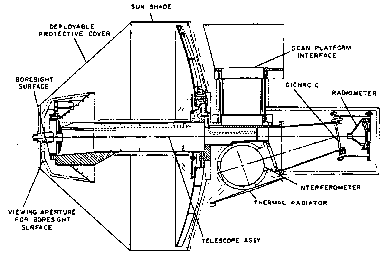mission / spacecraft / instruments
Infrared Interferometer Spectrometer and Radiometer (IRIS)
The IRIS actually acts as three separate instruments. First, it is a very sophisticated thermometer. It can determine the distribution of heat energy a body is emitting, allowing scientists to determine the temperature of that body or substance. Second, the IRIS is a device that can determine when certain types of elements or compounds are present in an atmosphere or on a surface. Third, it uses a separate radiometer to measure the total amount of sunlight reflected by a body at ultraviolet, visible, and infrared frequencies.
The Infrared Interferometer Spectrometer and Radiometer measures radiation in two regions of the infrared spectrum, from 2.5 to 50μm and from 0.3 to 2.0μm.
 A sideways diagram of the IRIS
A sideways diagram of the IRIS
Infrared Interferometer Spectrometer and Radiometer Objective
- Determination of atmospheric vertical thermal structure (which in turn aids modeling of atmosphereic dynamics).
- Measurement of the abundances of hydrogen and helium (as a check on theories regarding their ratio in the primitive solar nebula).
- Determination of the balance of energy radiated to that absorbed from the sun (to help investigate planetary origin, evolution, and internal processes).
